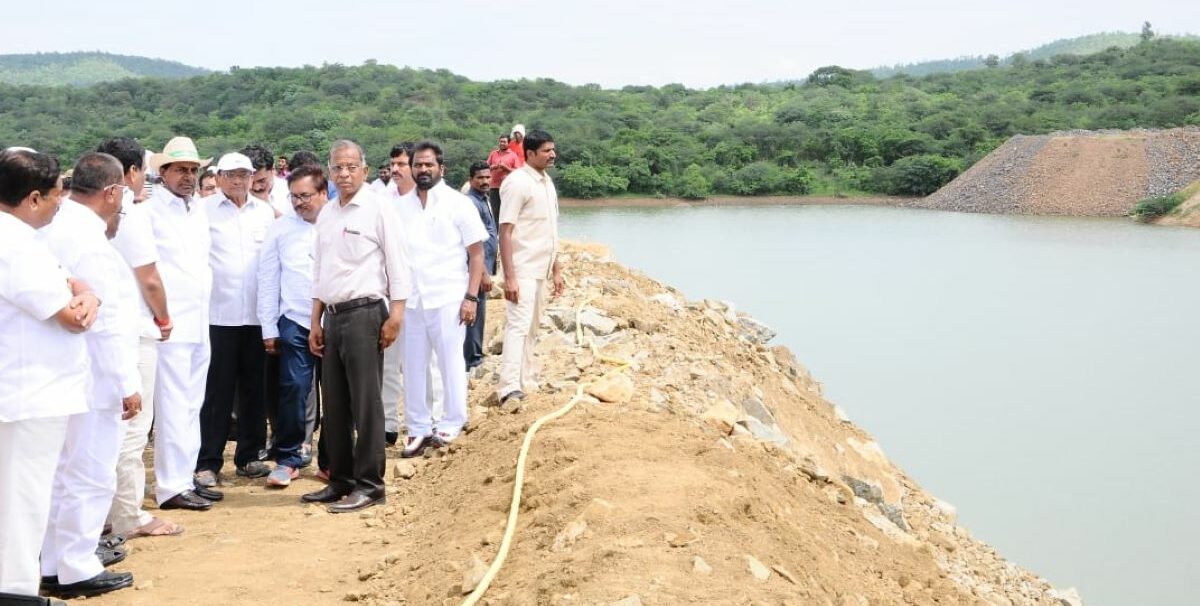The tribunal gave its verdict virtually while responding to petitions filed by D Chandramouleshwara Reddy and others.

Telangana Chief Minister KCR at Palamuru-Rangareddy Lift Irrigation Project site. (File Picture)
The National Green Tribunal (NGT) has imposed an environmental compensation and penalty totalling ₹920.85 crore on the Telangana government for proceeding with the construction of the Palamuru-Rangareddy Lift Irrigation Scheme (PRLIS) and Dindi Lift Irrigation Scheme (DLIS) in erstwhile Mahabubnagar district.
Before proceeding with the project, the Telangana government should have followed the procedure for obtaining environmental clearance — screening, scoping, public consultation, and appraisal.
Being a new project, the government was directed to submit the project report before the Krishna River Management Board (KRMB) and get their appraisal, as well as the approval and sanction of the Apex Council.
The tribunal gave its verdict virtually while responding to petitions filed by D Chandramouleshwara Reddy and others.
Since the tribunal was of the prima-facie view that the component of irrigation was envisaged in the project, the same could not have been proceeded without prior environmental clearance.
The Telangana government is not entitled to proceed with the project without getting environmental clearance. Telangana has been ordered to pay an environmental compensation of ₹528 crore — 1.5 percent of the project cost of ₹35,200 crore, in respect of PRLIS.
The Telangana government has also been ordered to pay an environmental compensation of ₹92.85 crore — 1.5 percent of the project cost of ₹6,190 crore, in respect of DLIS.
For willful violations of the orders of the NGT, a penalty of ₹300 crore was imposed on the state, which also has to be paid to the KRMB within three months.
The amount should be utilised for remediation activities at the project site and for Krishna river restoration activities, under the guidance and supervision of an oversight committee.
This committee must comprise senior officers above the rank of joint secretary in the central government and be from the Ministry of Forests, Environment, Forest and Climate Change (MoEF&CC), Ministry of Jal Shakti, Central Pollution Control Board, and KRMB.
The KRMB will be the nodal agency and the committee should be constituted within one month from the date of judgement. The plan of Krishna river restoration, covering all the riparian states, should be prepared by involving expert agencies such as NEERI.
It is open to the authorities to consult any experts in the fields of river basin development, pollution abatement, and riparian vegetation development. The proposed works should be implemented for the entire Krishna river on the lines of Namami Gange programme, with flexibility to incorporate new site-specific components.
Once the project plan is prepared and approved by the committee, the Ministry of Jal Shakti may entrust execution of the project to the KRMB and obtain necessary approvals, if any, from the central government.
As more than 75 percent of the project was completed without the Environment Impact Assessment (EIA) study and environmental clearance, the MoEF&CC was directed to constitute a committee from EAC members having expertise to go into the matter regarding mitigation, restoration, and rehabilitation measures.
Both the PRLIS and the DLIS should not be continued unless the required environmental clearance and other permissions, clearances, and consents are obtained under the relevant laws from the competent authorities, the NGT said.
The state government has taken up the PRLIS scheme to lift 90 TMC of flood water in 60 days from the foreshore of Srisailam reservoir on Krishna river to provide drinking water to 1,226 villages in 70 mandals, providing irrigation facilities to 12.30 lakh acres and also for industrial use.

May 18, 2024

May 18, 2024

May 18, 2024

May 18, 2024

May 18, 2024

May 18, 2024